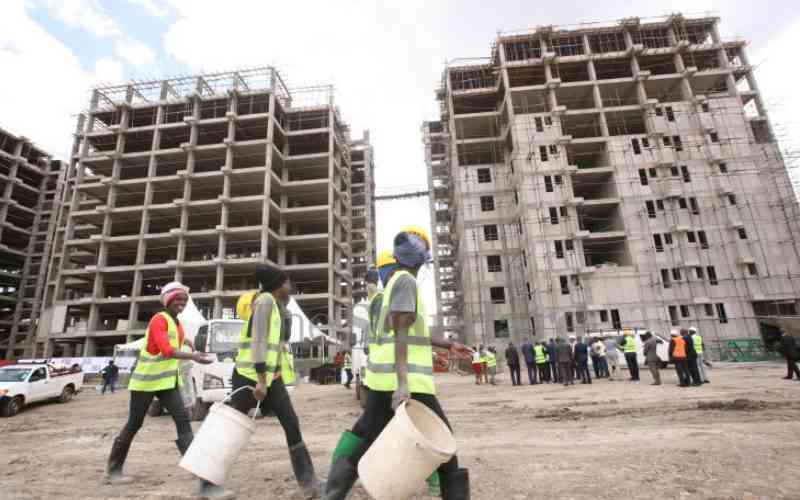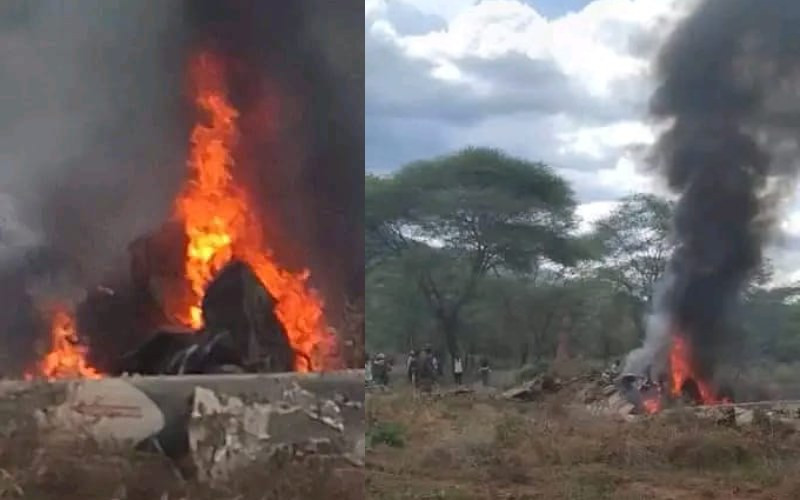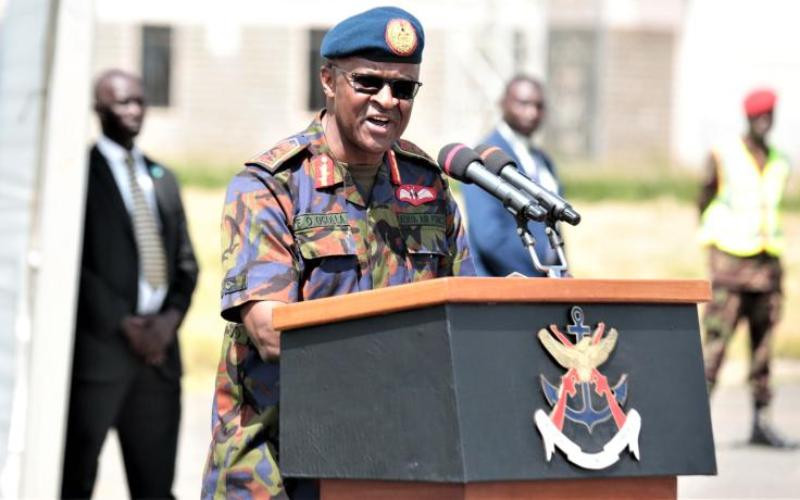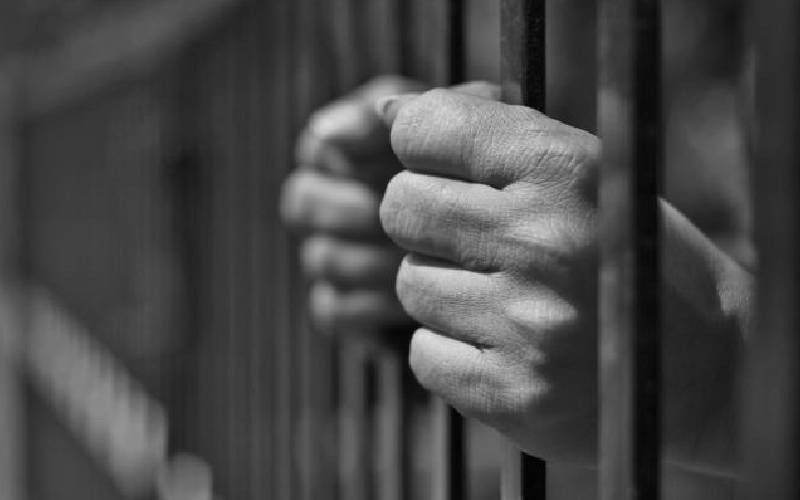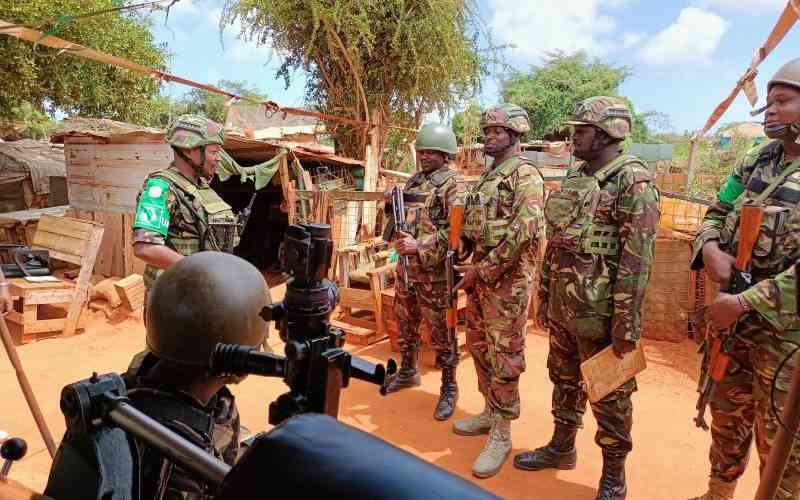
The barrenness of Kismayo, Somalia, is stark from thousands of feet above.
Besides the few shrubs that dot the plains, all that is visible from an aircraft window, beneath a few fleecy clouds, are miles and miles of emptiness.
Even from high above, the parched land looks as though it tasted its last drops of water ages ago. Only the sandy edges to the East, where the desert meets the Indian Ocean, are spared this thirst.
Few other things are discernible from the skies. There is the Juba River, which flows from Ethiopia, threading its way into the arid plains of Somalia and draining into the sea.
There is also the runway of the Said Abdulle International Airport, a facility fringed by military bases that sometimes has more donkeys than planes. The only stretch of tarmac in Kismayo runs from the airport into the heart of the town.
Twice every day, Kenya Defence Forces (KDF) soldiers leave their base and venture into town, down the only tarmac, for a visibility patrol aimed at keeping residents confident of their security.
They also conduct clearance patrols, through which they scan for explosive devices buried in the web of sandy paths that lead to the battlegrounds where fights with Al-Shabaab militia happen.
Occasionally, Somali security forces are part of the patrols and the operations that are carried out at least once daily.
They are expected to fully take charge in December 2024, when the KDF and security forces from other African countries will withdraw from the strife-torn country.
The KDF is part of the African Union Transition Mission in Somalia (ATMIS), which comprises military, police and civilian components from nine African countries.
ATMIS is a Somali government-led reconfiguration of the AU Mission in Somalia (Amisom), put in place in April this year.
A four-phased transitional plan will culminate in the withdrawal of the last of the 18,546 ATMIS troops in December 2024.
The exit is subject to an assessment of the security situation, as acting ATMIS head of mission Fiona Lortan told journalists from Kenya and Burundi last week at the mission headquarters in Mogadishu.
The first drawdown is expected in two months, with 2,000 troops pulling out of the horn of Africa nation.
Some 395 KDF soldiers, from a total of 3,634 will be part of the first withdrawal. Other drawdowns are scheduled for September 2023 and June 2024.
The plan is to have the Somali government recruit enough personnel to fill the void left by the gradual withdrawals.
For the first phase of withdrawal of 2,000, they will need to recruit 3,850 troops as replacements. The second drawdown will involve 3,000 ATMIS troops, to be replaced by 8,525 Somali soldiers. For the final exit in two years, the Somali government will need to generate 22,825 troops.
The Al-Shabaab, whose number is estimated at 6,000 to 7,000 fighters by one official account and 15,000 by another, will have to be decimated and the Somali forces fully trained and equipped to ward off any attempts of a resurgence before the foreigners depart.
ATMIS personnel conduct much of the training. Soldiers from other countries train the Somali National Army (SNA) on how to conduct operations and bomb detection and demolition techniques, even as they offer other critical military training.
Police officers mentor the Somali National Police (SNP) on intelligence gathering and best practices.
Al-Shabaab troubled regions are classified into six sectors. Kenyan troops are in charge of two, Sector Two, with its headquarters in Dhobley, and Sector Six, which they man jointly with Ethiopian forces.
Kismayo, where I spent two days during a recent trip to Somalia, is the headquarters of Sector Six, which runs south of Jubaland.
The fight against Al-Shabaab is as complicated as it is unpredictable. Over the years, the al-Qaeda-allied militia has evolved from an impatient group that got into futile confrontations with more advanced forces to one that carefully surveys its targets before attacking, employing techniques such as drone surveillance.
They also mostly prefer indirect warfare and targeted assassinations and kidnappings through their intelligence wing Amniyat.
"Their weapons of choice are Improvised Explosive Devices (IED) and mortars, which they can launch from a distance," ATMIS Chief Military Information Officer Colonel Mohamed Sirat, based at the Force Headquarters in Mogadishu, says.
The mortars are most effective at 4.5km away but can hit targets as far as seven kilometres away, making it an ideal weapon for the group running short of fighters.
The only tarmacked road in Kismayo is riddled with potholes, making a drive into the city mostly bumpy.
Besides the donkey carts ferrying firewood and an occasional lorry, the road, away from the city centre, is largely empty.
The vast flatness offers a drab view. The land is largely unoccupied, the result of the drought ravaging much of Somalia, the worst in four decades, as much as it is of the nation's forever war.
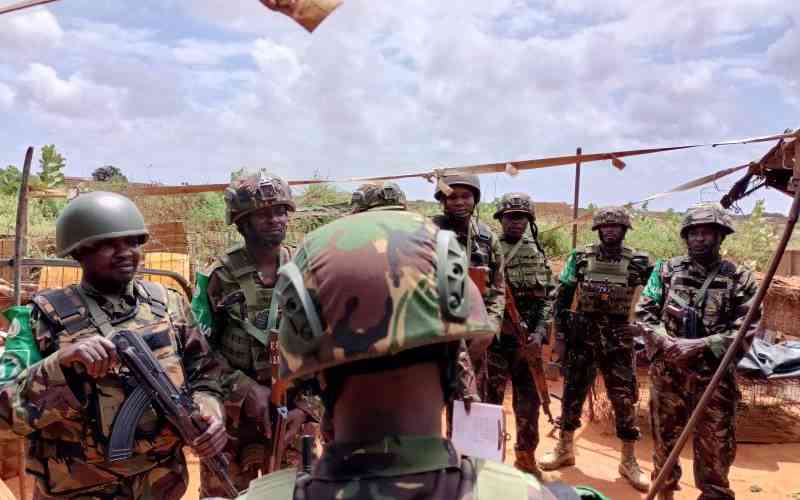
Somalia has been in conflict since 1991 when clan-based militiamen overthrew former President Siad Barre's government.
Several armed groups have fought to fill the power vacuum, but none has been as enduring or as devastating as the Al-Shabaab, whose insurgency sprung to the limelight in the mid-2000s.
Signs of the war are evident in the two or three rusty vehicles, destroyed by explosives.
They are written on the bullet hole-ridden walls of the city's structures yet to be renovated and in the KDF-run hospital next to their base in Kismayo, where two SNP officers are admitted for gunshot and IED-inflicted wounds, respectively.
Signs of the war reside in eyes of KDF soldiers from the Second Mechanised Infantry Battalion headed to town for a patrol aboard two Armoured Personnel Carriers (APCs) and a humvee.
Some soldiers are on their first tour of Somalia, which began in February this year.
Many are on their second, third and fourth tours. The latter have seen the best and the worst of the war: The liberation of Kismayo and other former Al-Shabaab strongholds and the frequent attacks that have claimed their brothers.
They know how quickly calmness transforms into chaos and how a deafening blast from an IED wrecks one's mental faculties, as a KDF soldier training their Somali counterparts on bomb demolition told me at the blare of a bomb at a detonation site in Kismayo. They know how easy it is to die.
Lt Col Nyamo Kasaine, the battalion's commanding officer, knows the danger into which his officers step whenever they set out on an operation.
"It's always a mixed feeling sending them out to an operation. But with the training that we undergo, I am always confident that they are prepared to face the al-Shabaab," Lt Col Kasaine says. Another soldier describes dying as one of the risks of the job, comparing it to the challenges that form part of any other job.
As the convoy of KDF personnel rolls into Kismayo, two men who appear locked in a heated argument pause briefly. Neither says a word. Neither will until the KDF soldiers get off their armoured vehicles.
Such patrols, despite having been the norm for more than 10 years, are head-turners.
The obtaining scene, silence, is much the same inside one of the APCs. None of the nine soldiers on board has uttered a word. Their eyes constantly scan through the tiny windows, scouting for signs of danger. Save for the opening through which a rifleman keeps watch, all other openings are shut as soon as the APC enters town, lending the sun-blasted vehicle oven-like conditions. Everyone's sweating.
Soon the soldiers disembark from their armoured vehicles to join SNP and ATMIS police officers keeping watch.

The two men who had been arguing, and the tens of city residents now huddled together in groups - will enthusiastically greet the soldiers, who have been part of their lives for over a decade. Some cheer. The younger ones will have their hands on their mouths, watching curiously as the soldiers move about.
Days earlier, KDF soldiers put out a fire that had gutted down a business premise. The fire, caused by an oil explosion, started in one of the warehouses that stores barrels of oil and had begun spreading to the adjacent buildings.
It would have razed down an entire section of Kismayo market had the forces not responded. And that is why the residents are cheering - that besides Yakub Hajir, who said he spent Sh3 million putting up the building and his female tenant, no one else lost their property.
"You have shown us brotherhood," Omar Abdullahi, Kismayo's mayor, tells KDF officers through a translator.
"We shall never forget what you have done," he adds, referring to their recent heroics and the work they have done in restoring security after decades of strife.
The al-Shabaab isn't an immediate concern to the residents of Kismayo, because they have been largely flushed out of the city.
A decade ago, the port city served as Al-Shabaab's headquarters. The Indian Ocean's high waters oiled the operations of the terrorist organisation.
Piracy was the order of the day and a charcoal-smuggling thrived. On the shores, the group extorted locals. Through all those ventures, they collected an estimated monthly income of Sh1.5 billion, much more than the government did.
KDF liberated Kismayo in 2012 in an operation code-named Sledgehammer. At the time, the Kenyan troops had joined Amisom, which had begun in 2007.
In 2011, KDF stormed Somalia in operation Linda Nchi.
Through multiple simultaneous operations, Al-Shabaab fighters have been pushed into hiding in the Juba valley, through which the Juba River flows. With the current drought in the country, many Somalis get their food through aid donations from the United Nations and other humanitarian organisations.
Many depend on agricultural activities along the Juba River, a permanent river that despite its varying water levels throughout the year, is to Somalia what the Nile is to Egypt, what the Tana is to Garissa and Tana River counties.
Efficient farming could see the river at its fullest sustain Somalia's entire population, estimated at 17 million. But that would, at the least, require a road network in place for food transportation and the sort of thing. None exists in the horn of Africa nation, thanks to years of lacking a functioning government.
The Juba River has gradually replaced the Indian Ocean as the fuel that runs Al-Shabaab's operations. With a consistent food supply that they have generally cut off from the rest of the country, they have fewer things to worry about as they fight to keep their strongholds, which include Jilib, their new capital, located at the banks of the Juba River. That is how they can conduct stake-outs that a KDF soldier estimated could take as long as six months, learning the enemy's patterns.
Their control of the nation's food basket has enabled them to employ a 'food donation' tactic in seeking public support. Somalis desperately need food and submit to the militant group for a share. And they pay the Al-Shabaab 'zakat', a form of tax, without much resistance.
Before ATMIS can fully hand over to the Somali forces, Al-Shabaab militants will have to be ejected from Jilib and other areas where they continue to wreak havoc, with a deadline of June 2024 set for the same. In other words, the success in Kismayo would have to be replicated in the rest of the country.
 The Standard Group Plc is a multi-media organization with investments in media platforms spanning newspaper print
operations, television, radio broadcasting, digital and online services. The Standard Group is recognized as a
leading multi-media house in Kenya with a key influence in matters of national and international interest.
The Standard Group Plc is a multi-media organization with investments in media platforms spanning newspaper print
operations, television, radio broadcasting, digital and online services. The Standard Group is recognized as a
leading multi-media house in Kenya with a key influence in matters of national and international interest.



